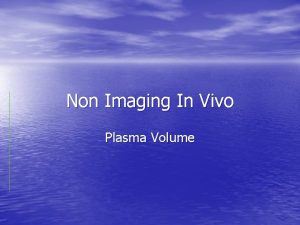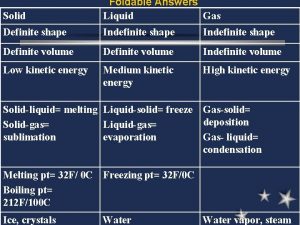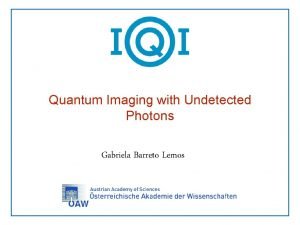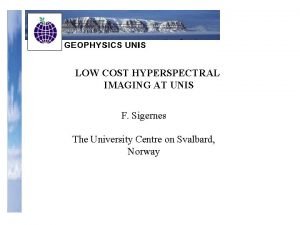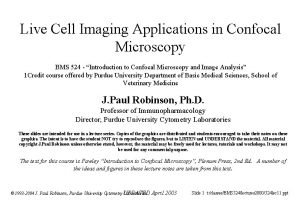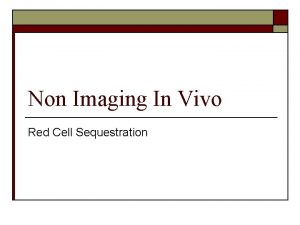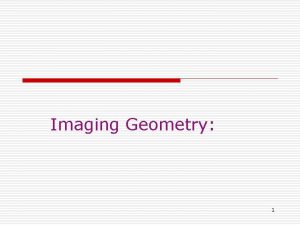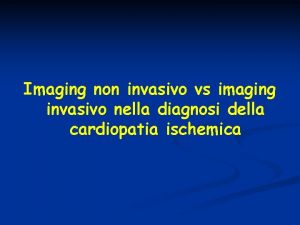Non Imaging In Vivo Plasma Volume Plasma Volume











- Slides: 11

Non Imaging In Vivo Plasma Volume

Plasma Volume • Usually performed in conjunction with RBC Volume. • It also aids in the diagnosis of polycythemia • Occasionally it is performed for fluid balance

Plasma Volume • The technique for measuring plasma volume is similar to that for RBC Volume. • I 125 RISA or HAS – I 125 labeled to albumin – I 125 has an energy of 32 ke. V • Thus plasma volume is performed prior to RBC volume, Cr 51 has an energy of 320 ke. V

Technique for Plasma Volume • Recommended to administer Lugol’s solution 4 - 5 days, everyday prior to administration of I 125 – Prevents thyroid uptake of Iodine • Inject 10 -20 u. Ci in a 1. 5 ml volume into the contralateral arm that samples will be drawn. – Count syringe in well counter to get CPM – Post injection count empty syringe • Withdraw three 15 ml blood samples at 15, 25, and 35 minutes post injection. • Centrifuge samples and divide into 5 ml aloquats.

Formula for Calculating PV PL Volume = (Full syringe - empty syringe) x CF Patient counts per sample drawn CF = cpm/ml from 5 ml volume x 2000 cpm from syringe above well CF is predetermined and maintained using specific procedure that may vary according to department or manufacturer.

Total Blood Volume • Total Blood Volume can be calculated after the plasma volume has been determined. • TBV = PL Volume 1 - (Hct x 0. 97 x 0. 91) – 1 - (Hct x 0. 97 x 0. 91) is equal to the corrected PLcrit • The correction factor is needed due to the F-cell ratio. This is the relationship between venous hematocrit and the whole blood hematocrit. The hematocrit of smaller vessels differs from that of larger vessels.

Formula Calculations • Plasma Volume (m. L)= Net Standard Count x 4000 Net Plasma Count • WB Volume (m. L)= Net Standard Count x 4000 Net Whole Blood Count • RC Volume (m. L) = Whole Blood Volume - Plasma Volume • Radioactive Hematocrit = Red Cell Volume Whole Blood Volume

Recalculating Plasma Counts • Approximately 10% of the • injected plasma dose will leak out of the vascular pool per hour. Therefore a correction must be applied. Take two separate blood samples form the patient and extrapolate the data. – – – 10 minutes = 20. 5 k 20 minutes = 16. 5 k Extrapolate to 0 time = 26 k

Normal Findings • Males and females 30 - 45 ml/kg

Condition Evaluations • Increased PV • Decreased PV – Addison’s Disease – Primary aldosteronism • Possible dehydration • Due to reduced blood flow to kidneys – Bacteremia • Bacteria take up part of plasma – Cushing’s Disease volume • Due to edema – Burns – Splenomegally • Loss of fluid from burned area • Can’t destroy damaged cells – Dehydration – Starvation – Polycythemia – Waldenstrom’s – Shock, hemorrhage, and trauma macroglobulinemia – Sodium deficiency • Malignant disorder, one • Responsible for regulating water symptom is bleeding disorders balance

Errors in PV • Not getting the nuclide in the vein • Wrong hematocrit Return to the Table of Content
 Volume in vivo of plasma
Volume in vivo of plasma Frc driver station mac
Frc driver station mac Debout jeunesse leve toi lyrics
Debout jeunesse leve toi lyrics Non functional plasma enzymes
Non functional plasma enzymes Non functional plasma enzymes
Non functional plasma enzymes Enzymes of blood plasma
Enzymes of blood plasma Solid volume definite or indefinite
Solid volume definite or indefinite Windows image acquisition
Windows image acquisition Quantum imaging with undetected photons
Quantum imaging with undetected photons Ohiohealth berger hospital mammography circleville
Ohiohealth berger hospital mammography circleville Affordable hyperspectral imaging
Affordable hyperspectral imaging Live cell imaging applications
Live cell imaging applications
